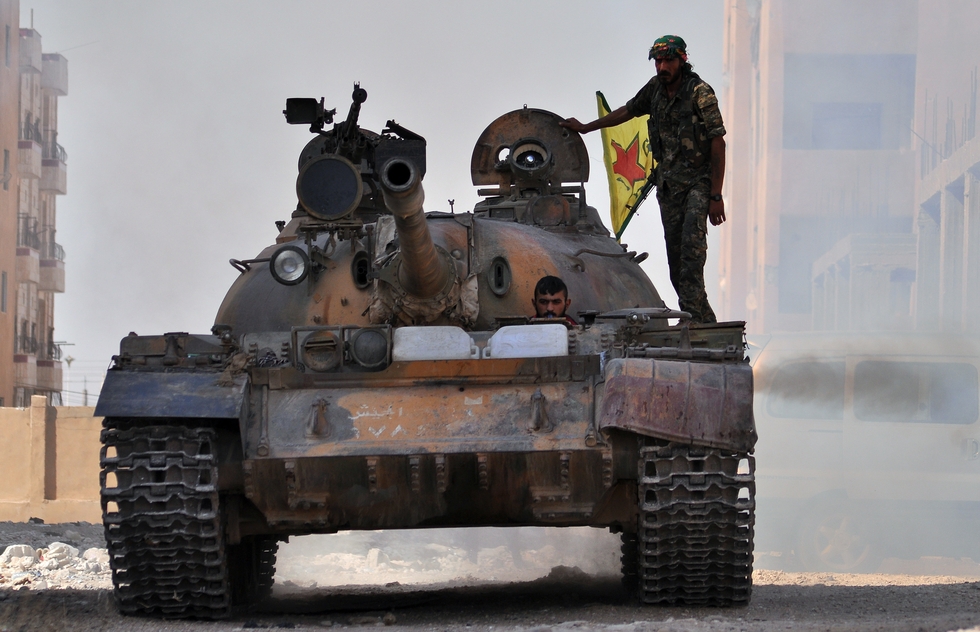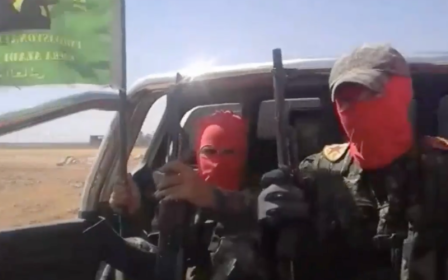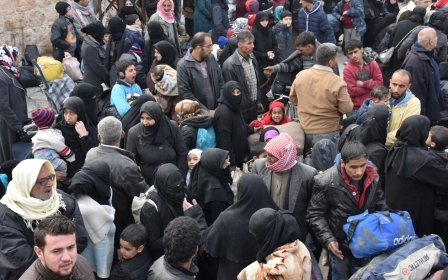ANALYSIS: The Kurdish 'frenemies' aiding Assad in Aleppo

As thousands of civilians flee eastern Aleppo following the simultaneous advance of Syrian government and Kurdish-led forces, rebel groups have alleged close coordination between the Kurdish People’s Protection Units, or YPG, and the Syrian army in its move to retake the city.
The Kurdish forces and rebels have clashed several times in Aleppo during the civil war around the strategically important Sheikh Maqsoud area which is controlled by the Kurds.
But in recent days, as the Syrian government forces press their advance on the east, Kurdish fighters have taken over areas abandoned by rebel forces, and allowed civilians trapped during months of siege to cross over to their territory.
“What we see is the regime and the YPG collaborating in Aleppo. They may not be fighting directly together but they are working together,” said Aleppo-based journalist Zohair al-Shimale.
“The Kurdish forces came in from Sheikh Maqsoud and the regime moved in from Haydariyya. They met in the middle. [The Kurds] helped the regime advance."
The Sheikh Maqsoud district has been under Kurdish control for many months, with serious clashes taking place between FSA-aligned rebels and the YPG forces.
Syria's main opposition National Coalition and the Syrian government oppose Kurdish demands for a federal state and full autonomy for Kurdish areas.
Following the recent government offensive, the YPG has taken over several new areas - Bustan al-Basha, Baiedeen, Hallak and Ain al-Tal came under their control on Monday.
Photos showing the Syrian national flag and the yellow YPG flag raised on top of buildings in Bustan al-Basha were circulated heavily across social media, suggesting that the Kurdish-led forces and Syrian army were in fact fighting together.
![]() The YPG, however, said the photos were fake, and denied any cooperation with the Syrian army. However sources on the ground believe that the YPG has helped weaken rebel groups in Aleppo.
The YPG, however, said the photos were fake, and denied any cooperation with the Syrian army. However sources on the ground believe that the YPG has helped weaken rebel groups in Aleppo.
“Clashes that started a week ago between rebels and the regime developed into new ones with the YPG,” said Roj Mousa, a Sheikh Maqsoud-based journalist.
“The rebels were being attacked by the Syrian army on one side while clashing with the YPG near Sheikh Maqsoud on the other,” he added, explaining that the rebel fighters withdrew to reduce their losses after realising they could not fight on two fronts simultaneously.
Speaking to a Free Syrian Army fighter in Aleppo, MEE contributor Shimale said that as Kurdish forces advanced, rebel fighters were left no choice but to surrender.
“Regime air strikes were very heavy as the Kurds were moving in. The rebels surrendered because they had nowhere to go.”
'Saving civilians'
However, according to the the Syrian Democratic Forces (SDF), the umbrella group under which the YPG is fighting in northern Syria, Kurdish factions only moved into new areas in Aleppo to protect residents and help civilians reach safe zones under their protection.
In a statement published on Monday, the SDF announced: “Our priority has been to protect residents in Sheikh Maqsoud and across eastern Aleppo. As attacks from the regime increased we moved into Bustan Basha and Hallak and established a humanitarian corridor to help civilians move towards safe areas.”
Nasir Haji Mansour, an adviser to the SDF's general command, told MEE that clashes between the rebels and the Syrian army led rebel groups to withdraw from several districts - leaving civilians unprotected.
“About seven or eight neighbourhoods were left empty when the rebels withdrew because of clashes with the regime,” said Mansour. "It was only then that the YPG moved in to these neighbourhoods to protect the residents and help them reach safety."
Mansour denied that the move had been planned in coordination with the Syrian army, saying the “YPG came in as a reaction to the escalation of events and clashes”.
Ahmad Araj, a senior official with the Syrian National Democratic Coalition, an opposition organisation that is part of the SDF, went even further, telling AP on Monday there was "something" of an agreement to surrender areas of northeast Aleppo to the SDF's Kurdish-led forces in exchange for guarantees to protect the civilians that come under their care.
He added that it was likely the SDF would absorb Arab fighters and moderate factions into its ranks: "We will coordinate with (the moderates) so we have a shared front."
But according to Mousa, the humanitarian crossing opened in Bustan al-Basha towards the Sheikh Maqsoud district came under YPG control after fierce clashes with rebel groups that had been in control the area.
“There were no negotiations nor was there an agreement reached between the rebels and the YPG,” said Mousa.
Shimale confirmed these reports after speaking to rebel fighters in Aleppo.
“The rebels haven’t negotiated or cooperated with the Kurdish forces at all, not about opening a humanitarian corridor nor joining their ranks to fight alongside one another,” said Shimale.
At the same time however, activists on the ground have reported civilians choosing to move towards Kurdish controlled areas feeling that they would be more likely to find safety under the YPG than in government-held areas.
“Residents of Aleppo have been fleeing to Sheikh Maqsoud and other Kurdish controlled areas because they feel they can trust the Kurds rather than the government,” said Najmeldin Khaled, an Aleppo-based journalist with the Shahba news agency.
The UN reported on Tuesday that 16,000 people fled from Aleppo with at least 8,000 moving into Kurdish-held areas according to SDF sources.
Friends or foes
Kurdish-led forces and the Syrian government ought to have no truck with each other since the Kurds have always opposed successive Syrian government and have suffered years of marginalisation at the hands of the Assad regime.
But the Syrian opposition has continuously accused the Kurds of cooperating with the Syrian government through its ally Russia, where the PYD opened offices in February to forge diplomatic relations with Moscow.
Kurdish relations with Assad and his allies have been complicated however.
For the past five years, the Kurds have carved out a region in the north amid the chaos in Syria, battling groups including Islamic State with their YPG militia while avoiding direct confrontation with Syrian government forces.
The Kurds’ resistance against IS won favour with the US, which first intervened on the side of the YPG with airstrikes in September 2014, when the militants looked poised to overrun the border town of Kobani.
Since then, cooperation between the two sides has deepened, with the US supporting the Kurds as part of the broader Syrian Democratic Forces.
But earlier this year, former British foreign secretary Philip Hammond announced that “disturbing evidence” had revealed that the YPG is coordinating with Syrian regime and the Russian air force.
And political and media advisor to the Syrian government Buthaina Shaaban said in a 20 February statement that Kurdish forces are coordinating with the Syrian government and Russia.
In the early days of the uprising, Assad withdrew most of his forces from Kurdish areas to focus on fighting rebels, leaving a small contingent of soldiers to man government bases in Hasaka and Qamishli.
Despite ongoing clashes between the army and the Kurdish forces across different parts of Syria, experts have pointed towards increased coordination between the two since July.
Fabrice Balanche, an associate professor and research director at the University of Lyon, said there had been co-ordination between Kurdish and Syrian government forces in Aleppo for some time.
He said the "supporting role" of Kurdish forces was crucial for the Syrian army to cut off the Castello Road, which linked east Aleppo with areas outside the city in July this year.
In an article published by the Washington Institute in July, he wrote: “From Sheikh Maqsoud, the YPG fired on the rebels defending the Castello Road. The YPG also attacked the Bani Zaid district, to the west of Sheikh Maqsoud, forcing the rebels to retreat to avoid being caught between the Syrian army and the Kurdish forces.”
“Whereas the YPG might have remained neutral in this battle, the group clearly indicated its preference through its actions, contributing to its overall strategy of co-operating with Russia in order to connect the Kurdish enclaves of Afrin and Kobane.”
But according to Alexander Clarkson, a lecturer in international studies at King's College London, any co-operation may be more through convenience than shared goals.
"The regime-YPG relationship is not stable. There isn't any particular sentiment tying the two together," he told MEE.
Sheikh Maqsoud journalist Mousa believed the apparent co-operation was unlikely to last. “Even if they are friends, they are enemies at the same time.”
Middle East Eye propose une couverture et une analyse indépendantes et incomparables du Moyen-Orient, de l’Afrique du Nord et d’autres régions du monde. Pour en savoir plus sur la reprise de ce contenu et les frais qui s’appliquent, veuillez remplir ce formulaire [en anglais]. Pour en savoir plus sur MEE, cliquez ici [en anglais].




